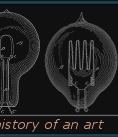The Cruto Lamp.
The characteristic feature of this lamp is the construction of its filament. A platinum wire of about 1/100 mm. diameter and cut to the proper length is bent in form of a horse-shoe, the extremities are inserted into metallic pincers insulated from one another, and the wire is then placed in a long glass vessel, through which circulates a current of pure hydrocarbon. The gas employed is olefiant gas, prepared from a mixture of 1/3 alcohol and 2/3 of sulphuric acid (free from sulphur). Before entering the collecting gasometer, the gas is purified by passing it through water and lime water, and also dried by means of calcium chloride and Nordhausen oil of vitriol.
Each vessel is placed in a shunt on the circuit of a Gramme machine, and the current can be regulated by means of a graduated resistance ranging from 1 to 200 ohms. As soon as the current passes, the platinum wire is raised to incandescence, and decomposes the hydrocarbon. Carbon is deposited on the platinum, and in proportion as the diameter of the filament is enlarged, its resistance decreases, and as soon as it has reached a certain point which, according to the requirements of the lamp, has been determined beforehand, the operation is stopped, and the filament is ready for mounting. In order to ensure a uniform deposition of carbon along the whole - length of the platinum wire, this latter, which is subject to the influence of the magnetic action of the earth, must be placed in a plane at right angles to the needle of an inclination compass placed in the magnetic meridian, and further, when the filament assumes a certain consistency, the current must be inverted, care being taken however that this inversion is not effected too soon. If the successive deposits of carbon are obtained in a uniform manner, the resulting filament is homogeneous and compact; if, on the other hand, they are not effected under the same conditions, a filament is produced, consisting of a number of individual superposed layers, and perfectly useless for practical purposes. The manufacturing of the filament takes, on an average, about two hours and a half. There can be no question that the filaments obtained by this method are most uniform in length, cross section and resistance.
The next operation is to attach the filament to the platinum wires which are sealed into the lamp bulbs. For this purpose the extremities of the platinum wires are formed into thin tubes, the filament is inserted into the opening and then introduced into the bulb containing the hydrocarbon. The current is passed again, and the carbon deposited on the incandescent platinum makes an excellent cement, which has never been known to fail.
The subsequent operations, namely, of placing the filament in the lamp bulb, of exhausting the air, and of mounting the lamp, are identical with the corresponding processes of other systems, and therefore need no further description.
The following lamps are manufactured by Messrs. Milde & Co., at Posiasco.
No. |
Candles. |
Volts. |
Amperes. |
Watts per candle. |
1 |
4 |
5 |
2.80 |
3.5 |
2 |
8 |
10 |
2.80 |
3.5 |
3 |
12 |
50 |
85 |
3.5 |
4 |
16 |
50 |
1.05 |
3.15 |
5 |
50 |
50 |
2.25 |
2.25 |
6 |
100 |
100 |
2.25 |
2.25 |
The objection to these lamps is that they take too large a current, and therefore do not lend themselves to distribution of light as readily as lamps of light resistance.











